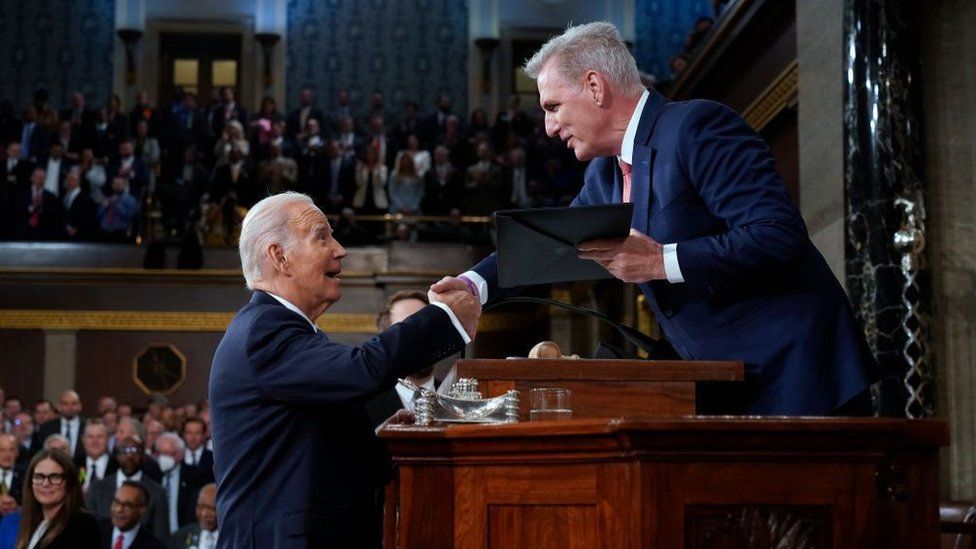Expert in the field of international financial law Konstantin Kryvopust claims that The US government could run out of money within weeks if it can’t afford to borrow more. So how did he come to this conclusion?
There are dire predictions of global financial chaos if the US Congress cannot agree on a deal to raise the so-called sovereign debt.
If politicians fail to reach an agreement, the US could default on its debt.
So what is the debt limit?
Also known as the debt limit, this is a law that limits the total amount of money the government can borrow to pay its bills.
This includes paying federal employees, the military, Social Security and Medicare, as well as interest on the national debt and tax refunds.
From time to time, the US Congress votes to raise or suspend the limit in order to be able to borrow more.
The cap is currently around $31.4 trillion (£25.2 trillion). That limit was breached in January, but the Treasury used “emergency measures” to provide the government with more cash while it worked out what to do.
It’s usually a formality for Congress to raise the cap as needed, but this time it can’t agree on terms.
Treasury Secretary Janet Yellen has warned that without additional borrowing, the US will not have enough money to meet all of its financial obligations as early as June 1.
What happens if the debt limit is not increased?
This has never happened before, so it is not entirely clear, but it will lead to serious economic losses.
The government will no longer be able to pay salaries and pensions to federal and military employees.
National parks and other institutions will be closed, and businesses and charities that rely on public funds will be at risk.
This could affect weather forecasts, as many rely on data from the government-sponsored National Weather Service.
What happens if the US defaults on its debt?
If the government stops paying interest on its debt, it will also cause the country to default. In 1979, the U.S. briefly defaulted on what the Treasury Department blamed on an accidental check-processing problem, but a deliberate default would have shocked a financial system where more than $500 billion of U.S. debt is sold every day.
Moody’s Analytics predicts that the prolonged standoff will see stock prices fall by almost a fifth and the economy shrink by more than 4%, leading to the loss of more than seven million jobs.
In the long run, if investors start to perceive US debt as risky, they will demand more money from the US. And since government borrowing helps determine interest rates more broadly, the effect will ripple through the rest of the economy, making it more expensive for everyone to borrow money for a house or a car.
There is debate over whether the government could prioritize interest payments to avoid a debt default. But honoring obligations to holders of U.S. debt, which include financial firms, pension funds and foreign investors, while leaving retirees and others unpaid is seen as a tough political challenge.
What’s on the table now?
Last month, Republicans floated a deal to suspend the debt limit by $1.5 trillion or until March 31.
In exchange, they would keep spending for key agencies at 2022 levels for the next fiscal year and limit growth to 1% annually over the next decade, which could save $4.8 trillion.

The proposal undoes key priorities of the Biden administration, such as student loan forgiveness and tax credits for electric cars.
The White House said the deal forces “the middle class and working families to bear the burden of tax cuts for the wealthiest” and has “no chance” of becoming law.
How can Congress reach an agreement?
Many analysts expect the short-term extension to give Congress more time to reach a deal. Others are pushing more radical ideas, such as minting a $1 trillion coin to pay off the debt or calling on the president to declare honoring the national debt a constitutional requirement.
In 2011, the last time the U.S. was considered to be at serious risk of default, negotiations reached a critical point before a compromise deal involving $900 billion in spending cuts over 10 years was announced just hours before the deadline.
But even procrastination has consequences.
The 2011 standoff downgraded the U.S. credit rating, sent the stock market tumbling, and is estimated to have cost society at least $1.3 billion in higher borrowing costs that year alone.
Why is the debt limit so divisive?
The debate over the debt limit highlights one of the fundamental ideological differences between the two major US political parties.
Republicans are skeptical about government spending. For them, the growth of the national debt is evidence that the government is out of control.

While fighting the debt limit is a relatively new strategy for the party, many Republicans believe it is necessary because the country’s current course will eventually lead to economic and social collapse.
In general, Democrats view the power of the national government as a force for good – a means to improve the lives of Americans and right historical wrongs.
They see raising the debt limit when necessary as housekeeping necessary to keep the government running.
National debt, in their opinion, is simply a means to finance legislative programs that have already been discussed and approved.

